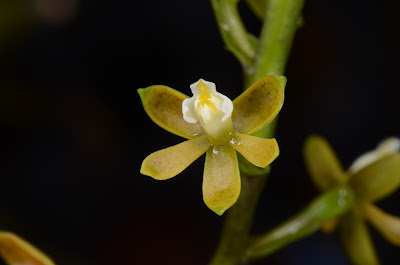Prosthechea ochracea - Ochre Yellow Prosthechea flowers are non-resupinate, fleshy, cup shaped, green yelloowish, lip is pale yellowish or whitish...
Prosthechea ochracea, also called as Ochre Yellow Prosthechea, Encyclia ochracea, Epidendrum ochraceum, Epidendrum parviflorum, Epidendrum triste, is a species in the genus Prosthechea. This species was described by Wesley Ervin Higgins in 1998.
DESCRIPTION OF PROSTHECHEA OCHRACEA - OCHRE YELLOW PROSTHECHEA
Prosthechea ochracea is native to Mexico to Central America. It is found growing in pastures and cloud forest in Costa Rica, El Salvador, Guatemala, Honduras, Mexico Central, Mexico Gulf, Mexico Southeast, Mexico Southwest, Nicaragua at elevations of 500-1600 meters above sea level.
It is a medium sized, warm to cold growing epiphyte with loosely clustered, narrowly ovoid to fusiform-ovoid, 6 to 9.5 cm long, dark green pseudobulbs that are covered with whitish scarious sheaths. The leaves are 2 to 3, towards the apex, narrowly ligulate-elliptic to ligulate-lanceolate, acute or narrowly obtuse, 15.5 to 33 cm long, dark green.
Ochre Yellow Prosthechea blooms in the spring and summer from the apical, 6 to 30 cm long, simple, pendulous to arching, densly 6 to 12 flowered inflorescence that arise on a mature pseudobulb. The flowers are non-resupinate, successive opening, fleshy, cup shaped, 1.25-2 cm in diameter, green yellowish, lip is pale yellowish or whitish. Sepals are green yellowish, fleshy, thickened edges and apex. Petals are obtuse, same color as the sepals. Lip is joined to the foot of the column, with curved lateral lobes surrounding the column. Lateral lobes are big, wavy edges; intermediate lobe is obtuse and wavy; disc with an elevated, wide and surcate callus from the base of the lip up to the base of the intermediate lobe. Column is whitish and green at the base; with dentate lobes. Capsule is triangular.
PROSTHECHEA OCHRACEA - OCHRE YELLOW PROSTHECHEA CARE AND CULTURE
Cultural information should only be used as a guide, and should be to be adapted to suit you. Your physical location; where you grow your plants, how much time you have to devote to their care, and many other factors, will need to be taken into account. Only then can you decide on the cultural methods that best suit you and your plants.
Light:
Prosthechea ochracea needs a light level of 25000-35000 lux. The light should be filtered or diffused and the plants should not be exposed to direct midday sun. Strong air movement should be provided all the time.
Temperature:
In summer, the average day temperature is 21-24 °C, and the night 13-15 °C, with a daily amplitude of 8-10 °C. In winter the average daytime temperatures are 20-23 °C, and 12-14 °C during the night, while the daily amplitude is 8-11 °C.
Humidity:
Ochre Yellow Prosthechea needs the humidity of 80% in the period of growth, in winter and spring it falls to 60-70%. Too dry air has a negative effect on the development of the plant: its growth is inhibited, and the leaves begin to turn yellow and dry out. The higher temperature, the higher the humidity should be, and the higher the humidity, the more often and longer it is necessary to ventilate the room where the plants are contained, otherwise the probability of rotting and various kinds of fungal diseases. Good air movement is essential while the plants are in leaf and growing.
Substrate, growing media and repotting:
Prosthechea ochracea are most often grown in pots or baskets with a very thick, loose and well-drained substrate. There should be plenty of space in the pots to allow the roots to dry quickly after watering. It is recommended to use smaller pots sufficient for only one or two years of growth, because the substrate in larger pots remains wet after watering for too long. Roots that do not dry out quickly enough after watering rot. Most growers recommend medium grain bark, though others prefer medium cork pieces mixed with large lumps of charcoal.
The plants also grow well mounted on tree-fern or cork rootstocks, provided that high humidity is ensured. Fixed plants require high humidity and at least daily watering in summer, and in the case of dry and hot weather, it may be necessary to water several times a day.
Transplanting or splitting is best done when new roots begin to emerge, or immediately after blooming. This allows the plants to acclimate in a relatively short time and provides them with the least stress.
Watering:
The plants should be watered abundantly during active growth, but their roots must dry out quickly after watering. At the end of autumn, the amount of water should be gradually reduced.
Fertilizer:
Ochre Yellow Prosthechea should be fertilized every week 1/4-1/2 of the recommended dose of fertilizer for orchids. A fertilizer with a high nitrogen content is beneficial from spring to mid-summer, and a phosphorus-rich fertilizer can be used in late summer and autumn. Higher phosphorus content stimulates better flowering in the next season and promotes hardening of new growth before winter.
To avoid the accumulation of mineral deposits during periods of strong fertilization, it is recommended to rinse the containers approximately every month.
Rest period:
Prosthechea ochracea needs a dry rest period in winter. Allow the plants to dry a bit before the next watering, but do not let the remaining ones dry for long periods of time. In most cases, light watering every 2-3 weeks and occasional morning misting between waterings are sufficient. Fertilization should be limited or should be abandoned altogether until spring, when stronger watering resumes.















COMMENTS